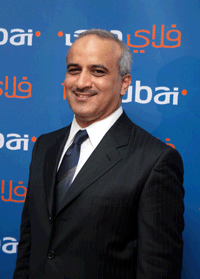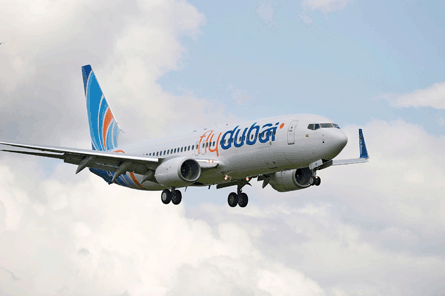Flydubai is the world's latest low-cost carrier arrival, having launched operations just one year ago this month, and is serious about its intent to replicate EasyJet and Ryanair's success in its own region.
"We live in the middle of almost three billion people," says boss Ghaith Al Ghaith. "And if you can offer them this easy, low-cost way to fly, then most people will travel more."
Former Emirates senior executive Al Ghaith has overseen the transformation of state-owned Flydubai shortly after it was established two years ago by government decree, when it was originally planned as to operate from the new Al Maktoum International airport at Jebel Ali, to fully operational airline based at Dubai's current international airport "DXB", with a staff headcount exceeding 500.
 |
|---|
© FlyDubai |
The airline has enjoyed phenomenal growth in its first 12 months, having added its 21st destination - Sri Lankan capital Colombo - in June and is well on its way to carrying its one millionth passenger this year.
The airline has eight 189-seat Boeing 737-800s in service and will add five more before the end of the year. "About 10-plus" will be added to its fleet each year from 2011, says Al Ghaith.
"Flydubai currently employs around 220 cabin crew and 130 pilots," says Al Ghaith. "Our expansion is very rapid and we expect to almost double these figures by the end of the year."
The one-year-old airline's stated mission is "to increase the number of people travelling to and from the UAE" through low fares. It joins established local rival Air Arabia, which is based up the road at Sharjah, in the region's embryonic but growing no-frills sector.
Air Arabia (see P20) serves more than 40 points across the region with a fleet in excerss of 20 A320s. Another growing rival is Kuwait-based Jazeera Airways, which has 11 A320s and serves more than 20 destinations.
But Al Ghaith is not concerned about sharing the region's low-fare market, saying that there is "big room to grow" and predicting that more will enter the market "as there are not enough right now".
 |
|---|
"If you can offer them this easy, low-cost way to fly, then most people will travel more"Ghaith Al GhaithFlydubai chief executive |
Flydubai launched with services to Beirut, and its network spans into eastern Europe (Istanbul) and stretches across to Asian points such as Kathmandu in Nepal. It extends across the Red Sea to Africa (Djibouti), while local destinations include Bahrain, Doha and Muscat.
Although the original plan had been to launch from Dubai's new airport, the lengthy delay in the opening of Jebel Ali - it will start this summer - prompted the switch to Dubai International airport. The existing airport's capacity has "finally got the relief it needed", says Al Ghaith, which means it will remain Flydubai's home "for the foreseeable future, but we will look to see how we can take advantage of Jebel Ali".
Although it is linked to Emirates Airline through their shared state-ownership status, that is where the connections end, says Al Ghaith. The airline did have some help from its big sister to get off the ground - Al Ghaith and other executives moved across and initially operated from the carrier's headquarters building - but now it is standing on its own.
It has its own operating licence and its own offices on the north side of DXB near its Terminal 2 operational base. And although some Emirates management moved over - including Al Ghaith who spent 22 years with the flag carrier - there is an arms-length relationship between the two.
"The bulk of our people come from outside [Emirates] - our pilots and cabin crew that represent the majority of our staff."
He adds that some cabin crew looking to start families have left their job at Emirates and joined Flydubai as it is easier to settle down flying with a point-to-point airline.
"We had almost 11,500 applications for pilots and cabin crew in our first few months, so it was very easy to get the people we needed."
Being a short-haul low-cost carrier, Flydubai structures its pilot pay and conditions differently to that of Emirates.
"We work our pilots and cabin crew as per the rules and we pay them as much as anybody else in the region," says Al Ghaith. Where it differs he adds, is that the airline avoids the old local traditions of providing transport and accommodation for crews like the network carriers - this is a legacy of the "old days" when there was little modern infrastructure in the Gulf region.
"The environment has changed, so we offer cash payments to our pilots and they have to make their own arrangements and that reduces our costs because we don't have to manage these services."
Cabin crew are able to share in the profit from on-board sales such as food and duty free goods, so their performance is reflected in their pay, says Al Ghaith. "This is good for the airline and good for the cabin crew."
Al Ghaith says that thanks to the 737 being so popular and "like a dinosaur - it's been around for a long time - lots of pilots [have a rating]". The airline's flightcrew are a multitude of nationalities including Europeans and "we even have some from South America", he adds.
But with a fleet of 50-plus 737s in the initial plan, Flydubai has been working to access a steady stream of pilots. Last year, a road show was held at an undisclosed European airline offering its flightcrew early retirement, which resulted in 64 potential recruits, says Al Ghaith. "We don't foresee any difficulty in recruiting highly qualified pilots - one thing I can say for sure is that the current economic circumstances have made this much easier than we expected it to be."
 |
|---|
© Flydubai |
The airline requires a minimum of 5,000h flying time for captains, with a minimum of 1,000h in command of 737 Classics or Next Generation variants as well as a minimum of 1,500h in command of a multi-crew, multi-engine aircraft (jet or turboprop) in excess of 10t maximum take-off weight.
Although the airline favours applications from 737-rated pilots, Al Ghaith says that going forward "we're always open to all the options to get highly qualified crew".
While there are plans for an in-house pilot training operation the services can be bought in locally from the Emirates-CAE joint venture training centre in Dubai. The airline does provide cabin crew instruction.
"Because there are not a lot of UAE nationals flying the 737s it is difficult to find the right experience locally," says Al Ghaith. "We will in the future consider a national programme to bring in more national pilots."
The majority of cabin crew recruited so far have no previous in-flight experience, so have been trained by the airline's own instructors. Although a Gulf Air 737 evacuation trainer in Bahrain was used initially, Flydubai now has its own in-house device.
"We have a rigorous selection process to ensure we are recruiting the right type of person and we then put them through an intensive five-week training course that covers all aspects of the job, with the main focus being on safety," Al Ghaith says.
Like the other airlines in the region the cabin crew are broad mixture of nationalities, with staff from 50 different countries including Europeans, Arabs, Indians and Asians. However the majority of cabin crew have been recruited from within the UAE.
Source: Flight International


























